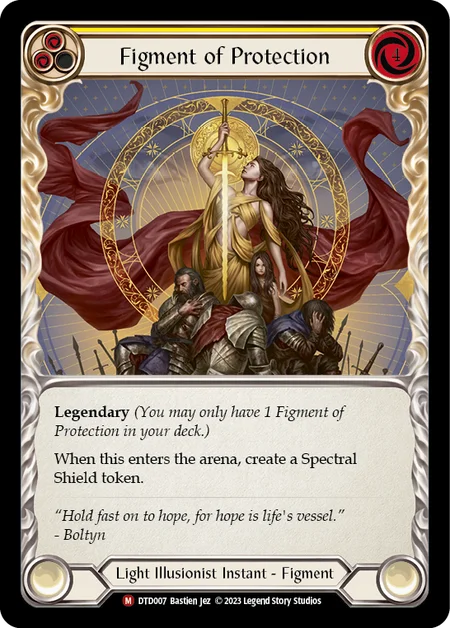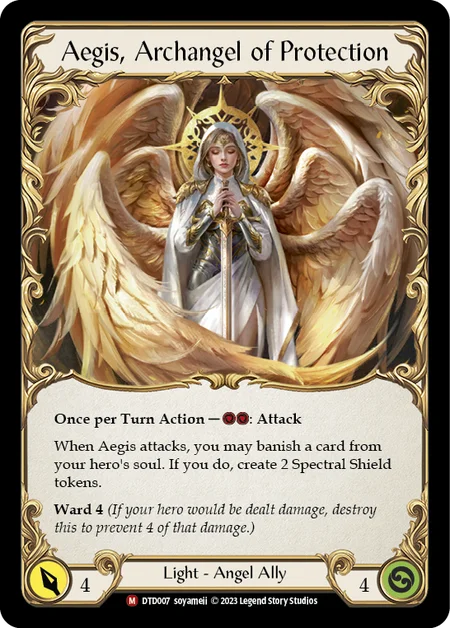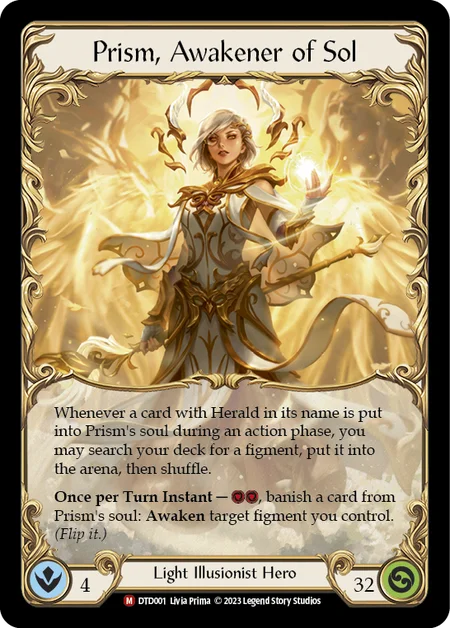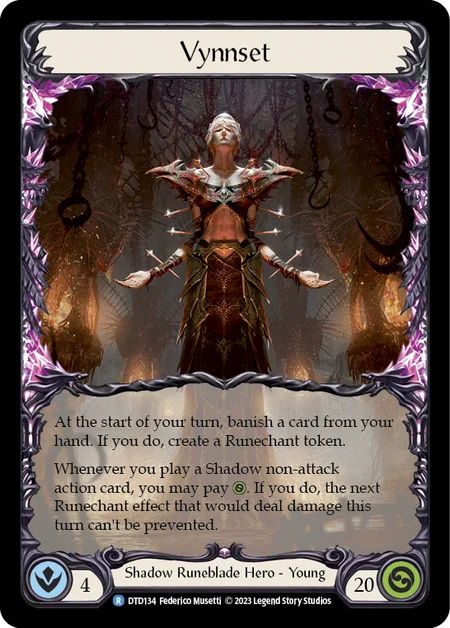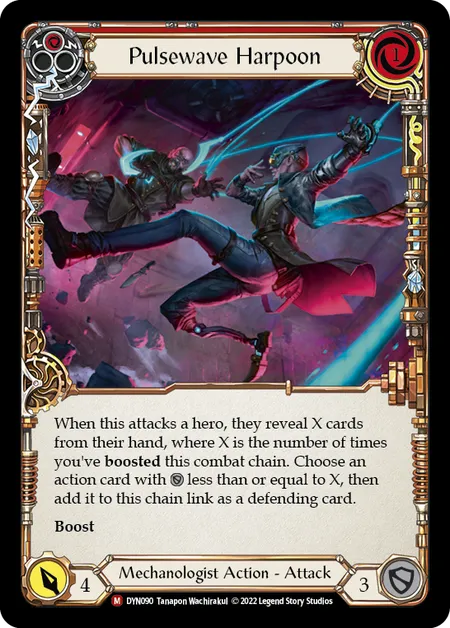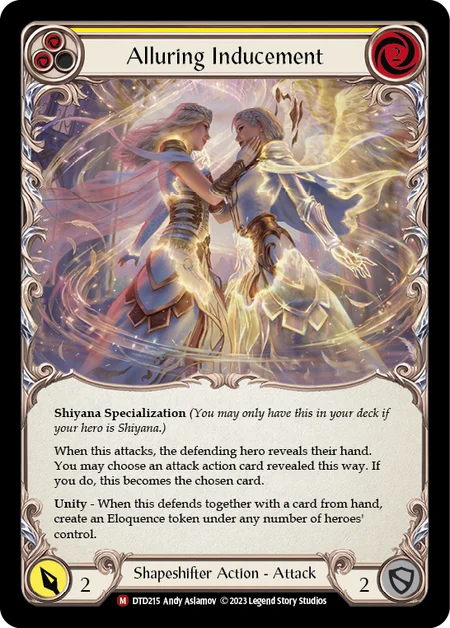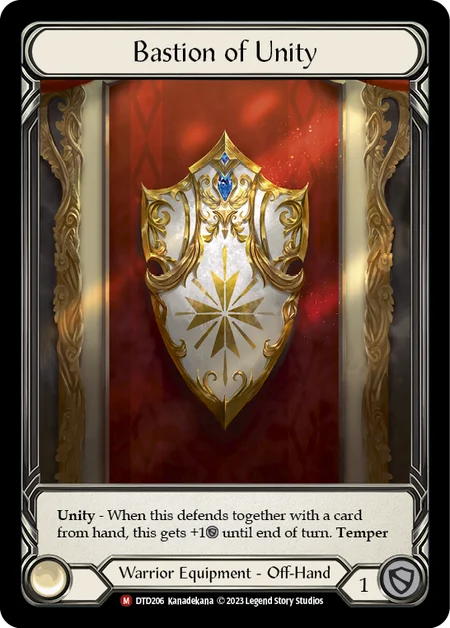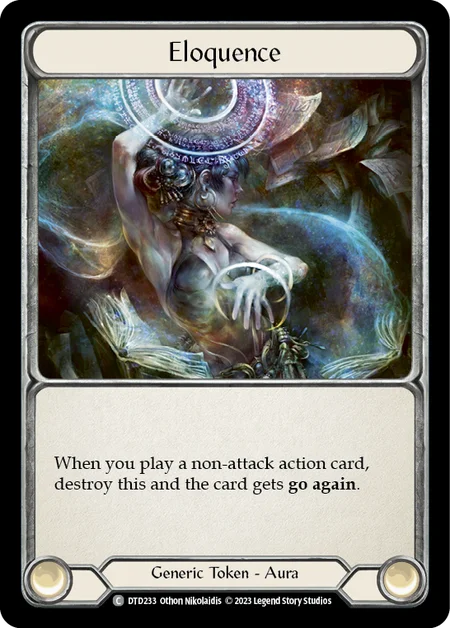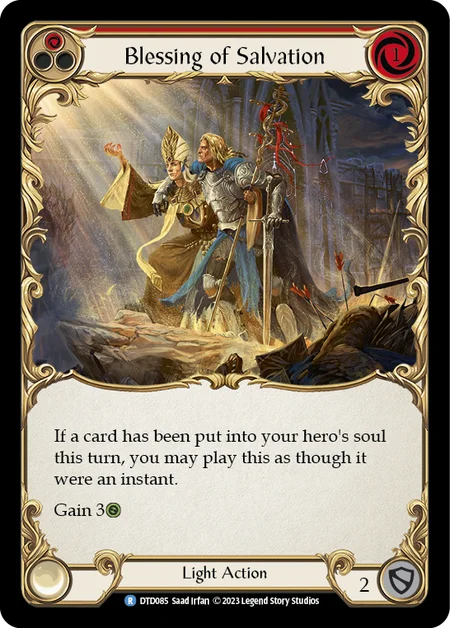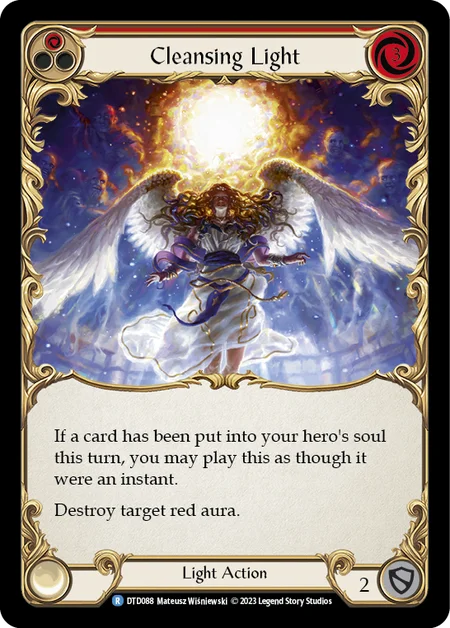Welcome back to another thrilling edition of Rules Reprise, where we shed “light” on the ever-evolving world of Rathe. Today, Joshua Scott answers some of the most common questions that have emerged from eager players before the full release of the new set Dusk till Dawn. If you want to know more about certain cards or interactions in the set, the Dusk till Dawn release notes are also available, which provide card-by-card rulings to guide you down the right path.
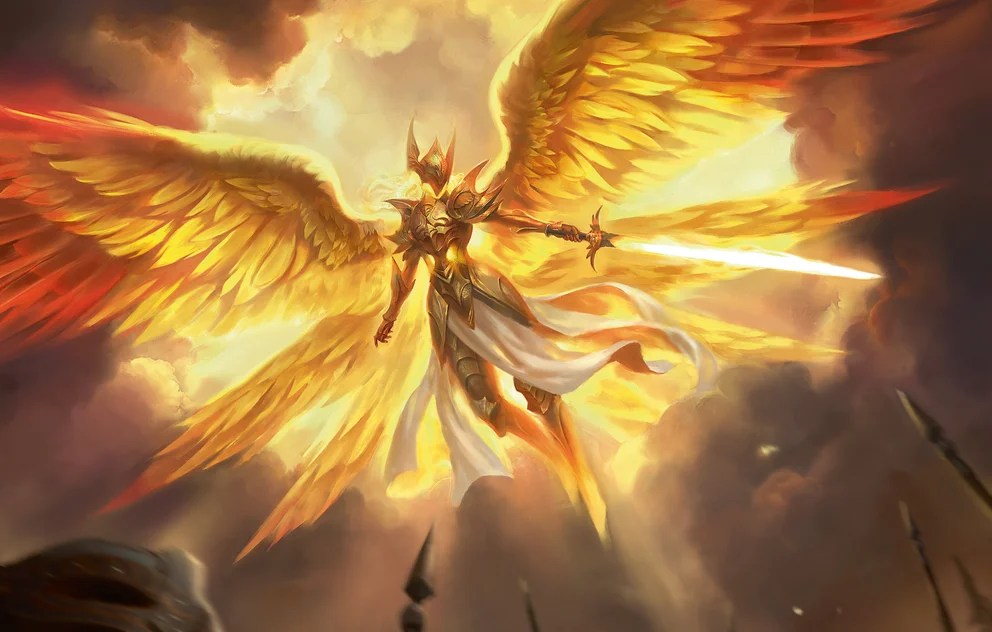
What’s the difference between charging and putting a card into soul?
Putting something into your soul is simply moving a card from somewhere to underneath your hero card. It doesn’t matter where the card came from, and is typically spelt out in non-italic text as “put it into your hero’s soul”. Charging is a step beyond that. Charge is a specific keyword that involves putting a card from your hand into your hero’s soul, and is it always spelt out using the charge keyword.
In short, charging involves putting something into your soul, but putting something into your soul is not considered charging. The notable exception is when you have a replacement effect like Spirit of Eirina, which changes where the charged card ends up. If you charge Spirit of Eirina, you’re still considered to have charged, but it has not gone into your soul. This is relevant for effects that specifically care about whether you have charged or if put something into your soul.
Tyler plays Cross the Line, charging Spirit of Eirina. Spirit of Eirina’s replacement effect changes the destination of the charge event from the soul to the arena. Tyler is considered to have charged, but has not put a card into their soul this turn. When they then play and resolve a Tome of Divinity, they only draw 2 cards.
How do I use the figment/angel cards?
Cards with the figment subtype are like auras, items, ash, etc. You can play them and when they resolve they just become permanents in the arena (figment side up). If you put them into the arena by resolving them, or by an effect, they’re considered to have entered the arena and will trigger any respective abilities. Once they’re in the arena, they stay there until something else happens to them.
To use the back-side of a figment/angel flip-card, you awaken it. This can currently be done using Prism, Advent of Thrones or Prism, Awakener of Sol. When a figment in the arena is awakened, it’s flipped to its back-side for the remainder of the time it’s in the arena. When it leaves the arena (typically when it's destroyed or killed), it flips back to its original figment front-face again.
Tyler is playing as Prism, Advent of Thrones. Tyler plays and resolves Figment of Protection, putting it into the arena as a permanent. Because it has entered the arena, Figment of Protection triggers and resolves, creating a Tyler a Spectral Shield. During their next turn, Tyler activates Prism, Advent of Thrones’ ability, targeting their Figment of Protection. When the ability resolves, the Figment of Protection flips to its back-face and Tyler now controls Aegis, Archangel of Protection.
What happens if an Angel is destroyed (by ward) when it attacks?
It depends…
When you declare you want to attack with an angel (and have paid the costs), you’re considered to be in the Layer Step of combat. The angel is not considered to have attacked yet, and this is the earliest point in time an opponent can respond to the action itself. If the Angel is destroyed (e.g. by ward) or killed (i.e. its life total is reduced to 0) at this step, the attack doesn’t trigger/resolve, the combat chain closes, and the controlling hero does not gain an action point (if the attack had go again).
When the angel’s attack resolves on the stack, you’re considered to be in the Attack Step of combat. The angel is considered to have attacked now, and any on-attack effects will trigger. If the angel is destroyed/killed at this step, the on-attack triggers will still resolve, but the combat chain still closes and the controlling hero does not gain an action point (if the attack had go again). This also happens for the Defend Step and Reaction Step of combat.
Finally, after the combat damage has been calculated/dealt (during the Damage Step), you’re considered to be in the Resolution Step of combat. The attack is considered resolved, but you have not gained an action point yet (that happens in the Link Step). If the angel is destroyed/killed at this step or anytime later in combat, the combat chain will not close. The angel has completed its attack and is no longer required to exist to keep the combat chain open and the controlling hero would gain an action point in the Link Step if the attack has go again.
Tyler attacks Nic with Suraya, Archangel of Erudition. During the reaction step, Nic activates and resolves Kraken's Aethervein. Tyler would be dealt 1 arcane damage but Suraya, Archangel of Erudition’s ward effect prevents the 1 damage and is destroyed in the process. Because Tyler’s Suraya is destroyed before the attack is resolved (they didn’t get to the resolution step), the combat chain closes.
What happens if damage can’t be prevented?
In general, prevention effects try to prevent the incoming damage but don’t end up reducing the amount of damage dealt.
For permanents with fixed-prevention effects like ward (i.e. “if you would be dealt damage, destroy this to prevent X of that damage”), this effectively means that they’re destroyed without reducing any of the damage that will be dealt. Worse yet, all of your permanents with ward may be destroyed trying (and failing) to prevent damage to your hero. If a prevention effect is optional (e.g. Dance of Darkness), you may still choose whether to apply it for unpreventable damage, but if you do, it still does not reduce the damage.
However, for ongoing-prevention effects like those from the Radiant equipment (i.e. “prevent the next X damage that would be dealt to you”), it doesn’t reduce the damage but the effect can still go on to prevent subsequent damage in the turn. Specifically, its prevention amount is not consumed/reduced by unpreventable damage.
Nic controls a Spectral Shield and Bellona, Archangel of War, and has activated Radiant Flow earlier this turn. Tyler is about to deal 1 damage to Nic that is unpreventable. Nic may choose the order that their prevention effects apply (they choose the Spectral Shield first, then Bellona, then Radiant), but cannot choose not to apply them because they are all mandatory (as long as there is damage to prevent). The Spectral Shield’s ward 1 tries to prevent the damage by destroying itself but fails to reduce the damage. Then because there is still 1 damage being dealt to Nic, Bellona, Archangel of War’s ward 4 effect tries to prevent the damage by destroying itself, but also fails to reduce the damage. Finally, because there is still 1 damage being dealt to Nic, Radiant Flow’s effect tries to prevent the damage, but fails to reduce the damage. In short, Nic takes 1 damage, loses their Spectral Shield and Bellona, Archangel of War, but retains the prevention effect from Radiant Flow which can still prevent up to 2 damage later in the turn.
How do you defend together with another card (for unity)?
There are currently three ways to defend with cards (add defending cards):
- declare the cards as defending during the defend step of combat,
- resolve a defense reaction card on the stack,
- and resolve an effect that adds a card as a defending card.
There is currently only one way to defend together with another card, and that is to declare two or more cards as defending during the defend step of combat. Defense reactions resolve and become defending one-at-a-time, so they can not defend together with other cards. And currently, there are no effects in the game that add two or more cards to the chain link as defending cards at the same time.
Lastly, for unity effects specifically, the card that you defend together with must be from hand. If none of the other cards you’re defending with are from hand, the card with unity will not trigger because you do not meet the trigger condition.
Nic controls Bastion of Unity. Tyler has boosted 2 times this combat chain and attacks Nic with Pulsewave Harpoon, boosting. Tyler chooses United We Stand from Nic’s hand to add to the combat chain as a defending card. During the defend step, Nic defends with two cards - Alluring Inducement (from hand) and Bastion of Unity. Bastion of Unity’s unity effect triggers because it defended together with Alluring Inducement (which was from hand). Alluring Inducement's unity effect does not trigger because Bastion of Unity did not defend from hand. United We Stand's unity effect does not trigger because it did not defend together with any other cards at all.
What happens if you play an action card as an instant with an Eloquence token?
When you play a non-attack action card, it will become a layer on the stack and trigger your Eloquence token (which becomes a triggered-layer on the stack). If you then play a non-attack action card as though it were an instant, it becomes yet another layer on the stack and triggers your Eloquence token again. When all of these layers resolve, both of your non-attack action cards (the one played normally and the one played as an instant) will have go again, and you’ll have gained 2 action points.
The triggered effect on the Eloquence token that gives a non-attack action card go again is not dependent on the destruction of the Eloquence token. As long as you keep playing non-attack action cards before the Eloquence token is destroyed, it will continue to trigger and give your non-attack action cards go again.
It’s also important to note that non-attack action cards played as though they were instants are still considered non-attack action cards for the purposes of effects. Playing an action card as though it were an instant simply means that you do not have to pay an action point to play it, and you may play it any time you have priority.
Tyler controls an Eloquence token and has put a card into their soul this turn. Tyler plays a non-attack action card (Layer 1), spending 1 action point, which triggers their Eloquence token (Layer 2). Before passing priority, Tyler plays Blessing of Salvation as an instant (Layer 3) which triggers their Eloquence token again (Layer 4). Passing priority back and forth, the layers are resolved in descending order. Eloquence’s trigger (Layer 4) resolves, destroying the Eloquence token and giving Blessing of Salvation go again. Blessing of Salvation (Layer 3) resolves. Eloquence’s trigger (Layer 2) resolves; there is no Eloquence token to destroy but it still gives the first non-attack action go again. And finally the non-attack action (Layer 1) resolves. In total, Tyler spent 1 action point, but gains 2 action points from the go again on both the non-attack action card and the Blessing of Salvation, thanks to the Eloquence token.



